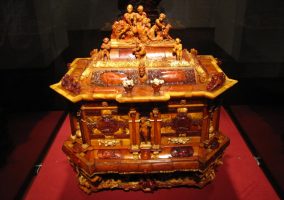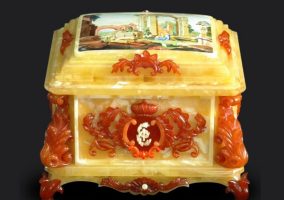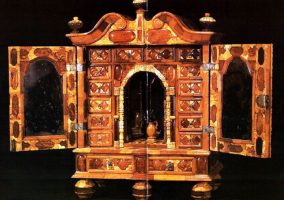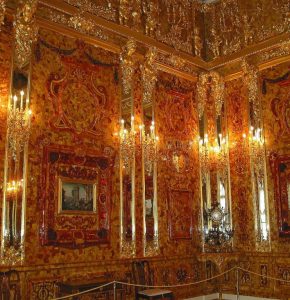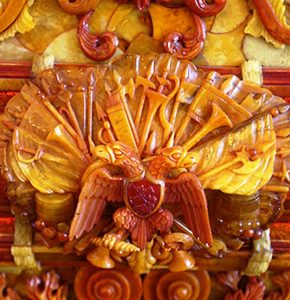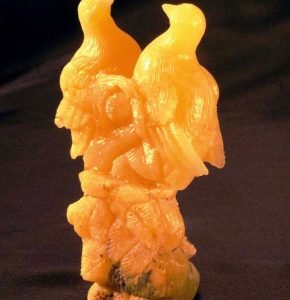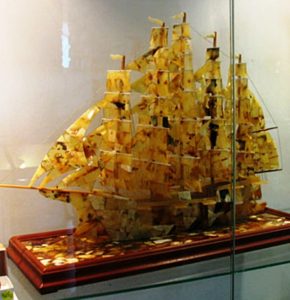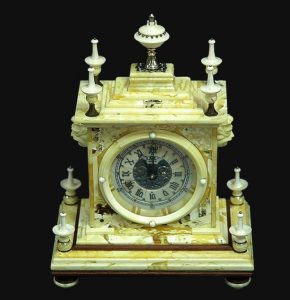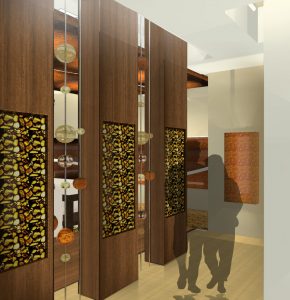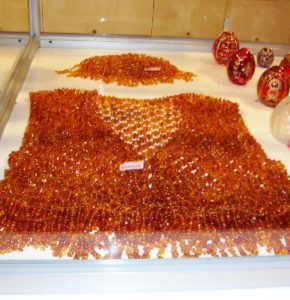After the fall of the Roman Empire and during the early Middle Ages amber was used solely for utilitarian purposes, identical serial rosaries and crosses were made, sometimes cult attributes. We don‘t know of any true artistic artifacts from that time. Also, much amber was used for incense and medical needs – medicine of the period didn‘t differ much from magic.
Amber products
Amber artisans were pooled only at Bruge and Liubeck in XVI, later on from XV amber-maker guilds were established in Dancing, Konigsberg and many other cities. Complicated mechanisms for amber treatment were found, ivory and enamel was used, the amber was gravured, scooped, cut and many ways to brighten the qualities of amber and its specific warm shine were created.
The artisans started from small artifacts indented for everyday use mostly using antique style and later on truly artistic creations were made: vases, chalices, plates, mirror frames, perfume flasks, tobacco holders, powder cases, various boxes and even small cupboards, sculptural compositions (statues and portraits) as we as other similar artifacts that were greatly adorned with carving and reliefs.
Nobleman houses and churches were adorned with these artifacts at the time and they were one of the most popular gifts during diplomatic visits. It‘s possible that amber artifacts that are now kept in the Moscow Armory Palace and St. Petersburg‘s National Hermitage got there in such a way.
The artistic treatment of amber is reborn during the Renaissance and especially flourishes during XVII – XVIII centuries. Very few artifacts from that period have survived because of amber‘s fragility and the hardships that swept through Europe of that time. Though, the creations that we have now are the treasures of many museums as they show the great sophistications of the artisans, their subtle taste and the feel of the material‘s specifications.
Besides art creations, the very clear and light amber was used in optics, for the making of eyeglasses, multiplications glasses and even for microscope manufacture in the middle of XVII. There‘s also data that knowledge of such lens making was known in Ancient Rome as well.
In the XVII century ways on how to make the yellowish amber totally clear and colorless were known, sadly today these methods are completely forgotten and lost.
We find many various recipes of making glazes from amber in the scientific texts from XVI century. They were mostly used to varnish musical instruments. It is thought that the famous Cremona violin artisans Nikolo Amati (1596 – 1684) and Antonio Stradivari (1644 – 1737) glazed their violins with amber glaze and this was the reason why their instruments sounded so special.
The most popular assortment of amber artifacts up until 1941 was tobacco pipes, cigarette-holders, clasps, crosses, pen heads, umbrella and cane handles, round necklaces, etc.
Amber pieces with unique inclusions that know are desired by all museums of the world were thought of as spoiled and thus it was grinded. The result of this procedure – melted and pressed amber. From this whole worthless surrogate plastic mass cumbersome writing kits, vases, chess and other „original“ artifacts are manufactured. To „improve the quality“ of this pressed amber green, blue, red and other paints are added: the received product doesn‘t differ from plain plastic.
Amber is considered a jewelry stone in Lithuania. Searches of Feliksas Daukantas – a painter form Klaipeda „Dailė“ (translates as „Art“) factory – and other members added a lot to this acknowledgement. Because of the sizable efforts of the traditional amber artisans, the Lithuanian amber industry freed itself from the old view towards amber as an ordinary and spirit-less material.
In „Dailė“ factory new amber processing methods were established since 1957 that were totally different from the previous ones. According to the opinion of the famous art researcher M. Tichomirova, Lithuanian painters and artisans were the initiators of the new view towards amber. In their works the most important thing is amber itself and all attempts of the artist are directed towards the highlighting of the natural beauty of amber and its aesthetics. Actually, this new view towards amber that‘s so spread now, got its roots in Lithuania where since the ancient times amber was viewed not only as having material value, but also a charm and a thing that encourages the heart.
THE TRADITIONS OF AMBER PROCESSING
Amber was used for various purposes for ages. The museum collections from various historic periods (starting from Neolithic and to this day) that include jewelry and other artifacts prove that amber was highly popular and was used widely in decorative arts.
The newest archeological finds urge us to make conclusions that even during the Neolithic period raw amber materials from the Baltic Region were traded with other territories. The settlers of other countries manufactured amber artifacts themselves. This is proven by the different stylistical nuances of the found adornments.
During the Neolithic and early Brass period amber couldn‘t be mixed with other materials. Though, in the late Brass and especially Metal age, amber was used together with other materials such as brass, glass, enamel and others in the making of necklace twinings.
Baltic amber reached the antique civilization centers such as Finikia, Greece and Rome in huge amounts where it was processed by local professional artisans. Such artifacts are mostly exhibited in Western European museums.
At Braiton (Great Britain) museum a 7,5 cm height cup is exhibited together with other professionally made artifacts of Brass age – an example of technical knowledge of amber processing.
Amber beads were decoratively inserted into brass setting of the late Brass age (for ex., in a setting with 3 beads that is exhibited in Sarajevo museum).
In some precious metal and ivory artifacts of 800-600 B.C. amber was used as a jewel inlay. Such is an ivory lion‘s head with amber eyes found south of Kiev, a plaque of a fantastic animal with amber eyes, a golden animal figurine with amber inlays at the years. The two latter artifacts were found in Cubane region and are exhibited in St. Petersburg‘s Hermitage collection.
In the territory of Roman Empire such famous amber processing and trade centers were located: Akvilea near the Adrian Sea, Maisilia (now Marseilles) near the Mediterranean Sea and others. These trade centers supplied amber artifacts to the settlers of the Empire and especially the nobility.
During the flourishing of the Roman Republic amber artisans created sculptures of penates, portrait human heads and their artistic expression didn‘t differ from the traditional marble or terracotta sculptures of the time. Few of such amber sculptures are kept in Dresden’s Albertan museum.
More widely and freely amber materials were used for figurine making during the Empire period (console-type sculptural group kept at Dresden museum and Amur and Psichea – at the Akvilea museum).
Amber rings with virtuously done sculptural women heads, Amurs and Psichea motives were very popular during the Empire period. Amber rings without adornments were also found. Amber amphorae and flacons, spoons, combs, lanterns and other artifacts also add to the findings of the period, but it’s highly doubted that they were actually used because of the fragility of amber. During the middle Ages the art of amber processing in Europe, especially in Germany, reached its artistic climax.
Amber artisan guilds started their activities in Bruge and Liubeck cities in the beginning of XIV. Later on such amber guilds appear in Stolp (before 1480), Colberg and Kioslin (mentioned in 1584), Dancing (1477) and Konigsberg (1641). The artisans of the mentioned guilds processed amber in various complicated ways: cutting, gravuring, inlaying, polishing, used sculptural plastic, etc.
Amber was used to satisfy the needs of feudal lords: for medallions, sculptural reliefs, crucifixes, tobacco pipes, tobacco holders, chess, powder boxes, perfume flacons and so on.
During XVII and XVIII centuries round sculptural and relief amber plastic was at its peak: chamber sculptures with mythological themes, figurines of saints, medallions with relief portraits of feudal lords. Amber mosaic-making was developed in XVIII. The greatest monument of this type of art is the famous Amber room that was in the Russian Czar’s palace and was snatched by the Nazis during the Second World War.
Amber room’s wall mosaics were born from the traditions of furniture inlay that already flourished in XVII. Cabinets, secretaries, home altars’ wooden surfaces were wonderfully decorated with amber mosaic inlays. Mirrors with cut amber frames or decorated with amber plates adorned homes of the very rich feudal lords.
A very high artistic and technical level was achieved by the skilled guild members when decorating wooden boxes for toiletries and keeping of precious jewelry. The typical figurative and floral motives on the boxes of Barroco and Rococo periods can be treated as separate miniature sculpture creations.
Amber also matches some precious metals especially if it’s not treated as a jewel. Probably because of this goldsmiths of XVII-XVIII century liked to incrust with polished amber decorative silver and gold crockery, mugs, goblets and trays. There are many of such fine artifacts in Russian museums.
At the National Hermitage tobacco holders adorned with amber, amber chess figurines and boards as well as other artifacts of XVIII are kept. Even greater amber collections are kept at the Moscow’s Kremlin Palace of Arms (Oružeinaja palata). Here more than 30 various XVII-XVIII century artifacts are kept, gifts given to Scars by the foreign messengers – gold, silver, enamel and amber adorned goblets, mugs, candle-holders, vases. According to the lists there were more of such gifts from Western European famous artisans in the Armor palace, though part of them didn’t survive to this day.
An amber cup that was mentioned in the lists and brought by the messenger Stanislovas Venenskis from the Great Duchess of Lithuania and presented as a gift to Scar Aleksey Michailovich in 1648 didn’t survive as well.
During the XVII-XVIII centuries decorative amber motives were successfully added to metal lamps-candle holders and chandeliers. A special influence is also made not only by amber itself, but parts of it that were sculpturally laid into flacons, powder boxes, tobacco holders, various other boxes. Amber artifacts kept at various European museums show that the use of amber was greatly expanded, got into applied Art sphere and enriched its processing techniques because of the needs of the nobility. And this in part conditioned the nature and use of the individual artifacts.
It’s interesting that during the middle ages amber was comparatively rarely used for women jewelry. Nevertheless, the masters of the time successfully used amber for chamber sculptures, mosaics and inlaying and most of the times demonstrated high artistic and technical culture. However it has to be admitted that amber suit women’s jewelry best.
 EN
EN LT
LT

